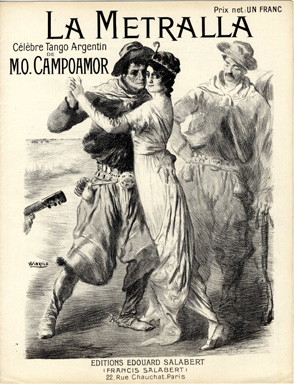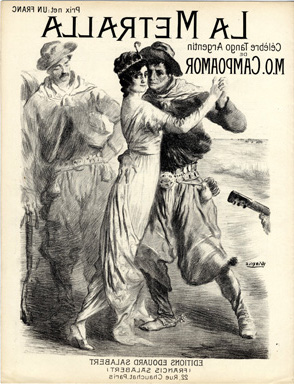French Sheet Music, 1913 – A Woman Leading a Man?

A Woman Leading a Man? French Sheet Music, 1913.
Ray Batchelor writes: Commercial imagery of women leading other women is commonplace. Commercial Imagery of women leading men is rare, indeed, to date (2 October 2018) this is the only example I have found.
This is an illustration taken from French 1913 sheet music for the tango “La Metralla”, originally composed in 1902 by Uruguayan, Manuel Oscar Campoamor. It is an arrangement for piano.
The image implies some story to warrant what she (La Metralla, presumably) is doing – but what story? A lovely, crisp version of this tango recorded by Francisco Canaro has no words to help https://youtu.be/ndzY1TMTA3I
We can, perhaps, get a feel for the kind of story it might have been. “Metralla” can mean “shrapnel”, so some sort of confrontation seems likely, but can also means small change, as in metal coins.
The Tango thread website https://tangothread.com/2018/08/16/manuel-o-campoamor/ gives a credible referenced biography of Campoamor. “The tangos of Campoamor are the fast paced, lighthearted and often naughty tanguitos of the 1890’s. These are among the very first compositions which can be fully distinguished from other musical genres that came into the creation of argentine tango such as the tango andaluz and the milonga… He is remembered as one of the great pioneers and proponent of the ‘guardia vieja'” or old school. https://tangothread.com/2016/08/08/guardia-vieja-1895-1925/
“Lighthearted and naughty”? Certainly, that is the feel of the jaunty Canaro recording, but without the story, we can only guess at what is supposed to be going on, at why she stares at the onlooker with such challenging directness.
Remarkable!
Of course, there may be an alternative, somewhat duller explanation involving not radical transgression, but a simple technical problem in producing the image. Notice, the proprietorial hand of the man on the woman’s rump, something a rough, assertive leader might do. Notice the look of appraisal of female flesh by the onlooker gaucho – so commonplace, so heteronormatively “normal”. And notice – oddly – that the non-dancing gaucho holds his whip in his left and not in his right hand, as would have been normal. And the guitar in the image is being held upside down…

Flip the image on its vertical axis and everything become plain. The whip is then in the “normal” right hand, the guitar is conventionally held, the man is now leading the woman as “normal”, and the direct stare is only that of a woman challenging us to acknowledge her choice of partner, or to acknowledge her fate, if he was not her choice at all.
The reversed image would have been the image the engraver would have seen on his plate. It is interesting, but unremarkable. Did he really forget that in printing, everything – including the tango hold of the dancers – would be reversed?
Perhaps he did. Yet his error leaves us with an image which, when it circulated in early 20th century Europe, may, unwittingly, have provoked all kinds of comments and discussions.
The search, meanwhile, for an historical image that really does show a woman leading a man is not yet over.
From the Bibliothèque national de France:
Célèbre tango argentin, composé en 1902
Edition de la version pour piano : Paris : E. Salabert, 1913
http://data.bnf.fr/en/15936698/manuel_oscar_campoamor_la_metralla__piano/